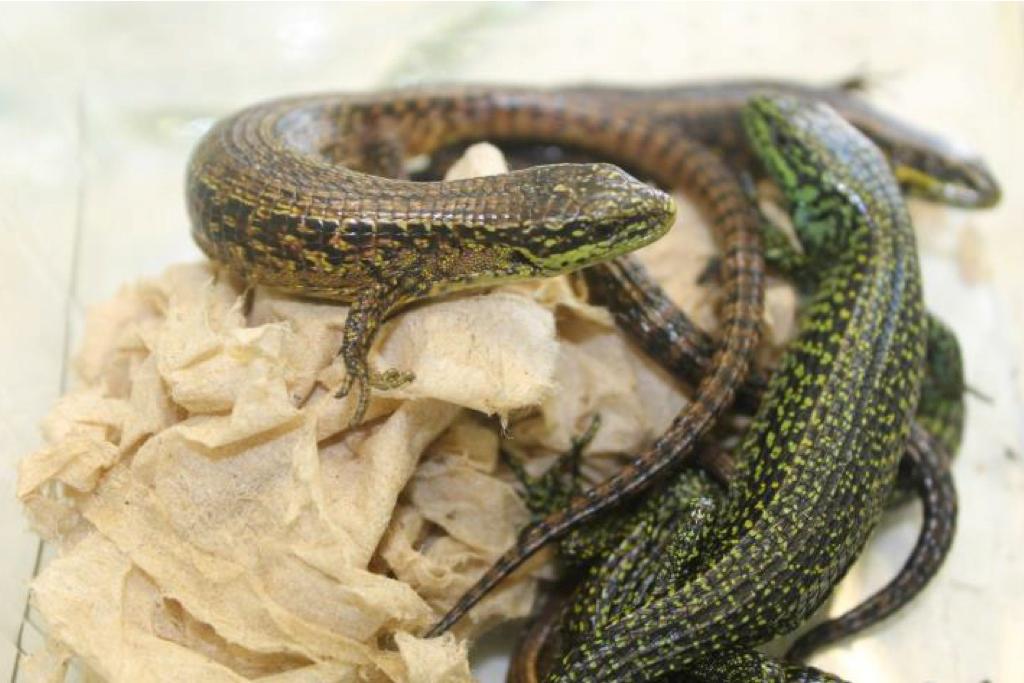Costa Rica deports a German caught smuggling over 400 frogs and reptiles in takeout containers
Some of the hundreds of lizards and frogs Costa Rican officials seized at San Jose’s airport.
SAN JOSE, Costa Rica — Maciej Oskroba doesn’t use takeout containers to carry food. He prefers to fill them with live reptiles and amphibians.
At least that’s what police at the Costa Rican capital’s international airport are saying. When they searched the 31-year-old German’s luggage on Sept. 9, they found: 184 frogs, 42 lizards, nine snakes and 203 tadpoles — all in plastic food containers stuffed with leaves.
Oskroba was headed to Panama en route to Dusseldorf, Germany, where police suspect he planned to sell the animals.
“In my 20 years working at the airport this is the largest wildlife trafficking case we’ve seen,” said Carlos Viquez, the chief of airport security.
The size of this seizure is rare even in this Central American nation fighting to stop smugglers from taking off with its tropical treasures. The illicit trade of animals has long been a problem here. Last year alone, Costa Rican authorities seized 239 birds, 82 reptiles and 159 mammals from border checkpoints, roadblocks and private homes.
It’s gotten so bad that in 2012 the government declared animal trafficking a criminal offense, increasing the penalties for participating in the illegal trade, but the full penalties are rarely imposed.
Oskroba could have faced a fine or prison. But after the authorities held him for little more than a week, he's being deported Thursday to Germany.
World's fourth largest illicit trade
Other animal traffickers skirt capture all together, and illegally captured creatures — some of which are endangered species — make their way onto the global black market for wildlife and animal products. If you include illegal timber and fish, wildlife trafficking is the world's fourth largest illicit trade, bringing in $7 billion to $23 billion annually, according to estimates by the United Nations Environment Program.
During his two decades working at the airport, Viquez says he's caught foreigners attempting to smuggle anything from hummingbirds to red-eyed tree frogs. Once, a man tried to sneak two white-nosed coatis through security in a wooden crate.
According to Rafael Gutierrez, an official with Costa Rica's National System of Conservation Areas (SINAC), the country's tropical fauna can fetch a high price in foreign markets.
"Certain species of snakes and frogs can be worth up to $1,500 in Europe," Gutierrez said. "We get reports when a species from this region is seized elsewhere and Europe seems to be where most Costa Rican animals wind up."
![]() Takeout food containers were used to smuggle hundreds of frogs, lizards and snakes. (Courtesy of Costa Rican government)
Takeout food containers were used to smuggle hundreds of frogs, lizards and snakes. (Courtesy of Costa Rican government)
Oskroba’s collection could have been worth thousands of dollars in Europe, where, according to online exotic pet shops, customers might have paid $50 for a translucent glass frog — of which he had 57 — or up to $300 for his lone boa constrictor.
But while wildlife trafficking can be lucrative for smugglers, it’s a nightmare for the preservation of biodiversity. The World Wild Fund for Nature says, after habitat destruction, animal trafficking is the second biggest threat leading to species' extinction.
Even when poor transport conditions don't kill the smuggled animal — which happened to more than a few of Oskroba’s creatures — wildlife trafficking pulls healthy animals out of the gene pool. Other animals, like Costa Rica's jungle cats, are purposefully killed for their pelts or other valuable products.
More from GlobalPost: Spain is Africa's animal-trafficking gateway to Europe
Once illegal pets do find homes, many are released into the wild by fed-up owners. In non-native environments, these exotic animals can prey on native species, or simply wreak havoc on an area's human population. This is the case not only in high-volume animal trafficking destinations like the United States and Europe, but also in the home countries of the stolen living bounty.
"Here in San Jose we frequently find animals that people have brought back from the beaches or jungles as pets," SINAC's Carlos Gomez said of Costa Rica’s not-so-green capital city. "When people get sick of the pets they will often turn them over to us, but other times they just release them in the city."
Birds and iguanas seem to be the favorite pets for urban dwellers here, but occasionally a more dangerous creature makes its way into the city’s ecosystem.
Last week, conservation officials pulled a caiman from the small lake of one city park. This tiny crocodile caused quite a stir, eluding capture for more than a month. But this isn't the first time one of the reptiles settled down in San Jose.
"This isn't a new problem in Costa Rica or anywhere," Juan Bolaños, a crocodile expert involved in the capture mission, said in a statement. "This is the fourth caiman I have personally captured from [the park]. People need to stop releasing their pets wherever they please."
Follow Costa Rica-based journalist Lindsay Fendt on Twitter @LEFendt.
Every day, reporters and producers at The World are hard at work bringing you human-centered news from across the globe. But we can’t do it without you. We need your support to ensure we can continue this work for another year.
Make a gift today, and you’ll help us unlock a matching gift of $67,000!
